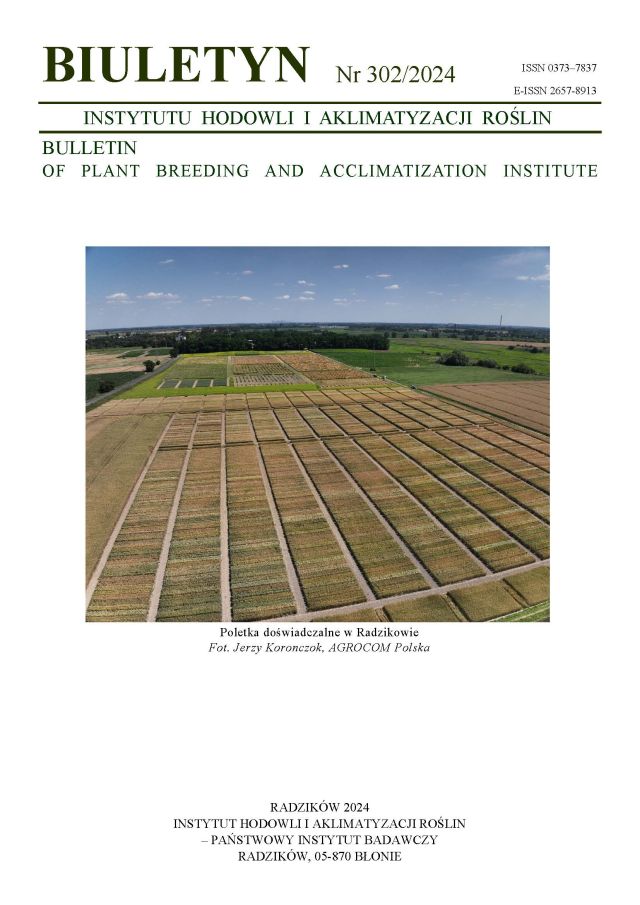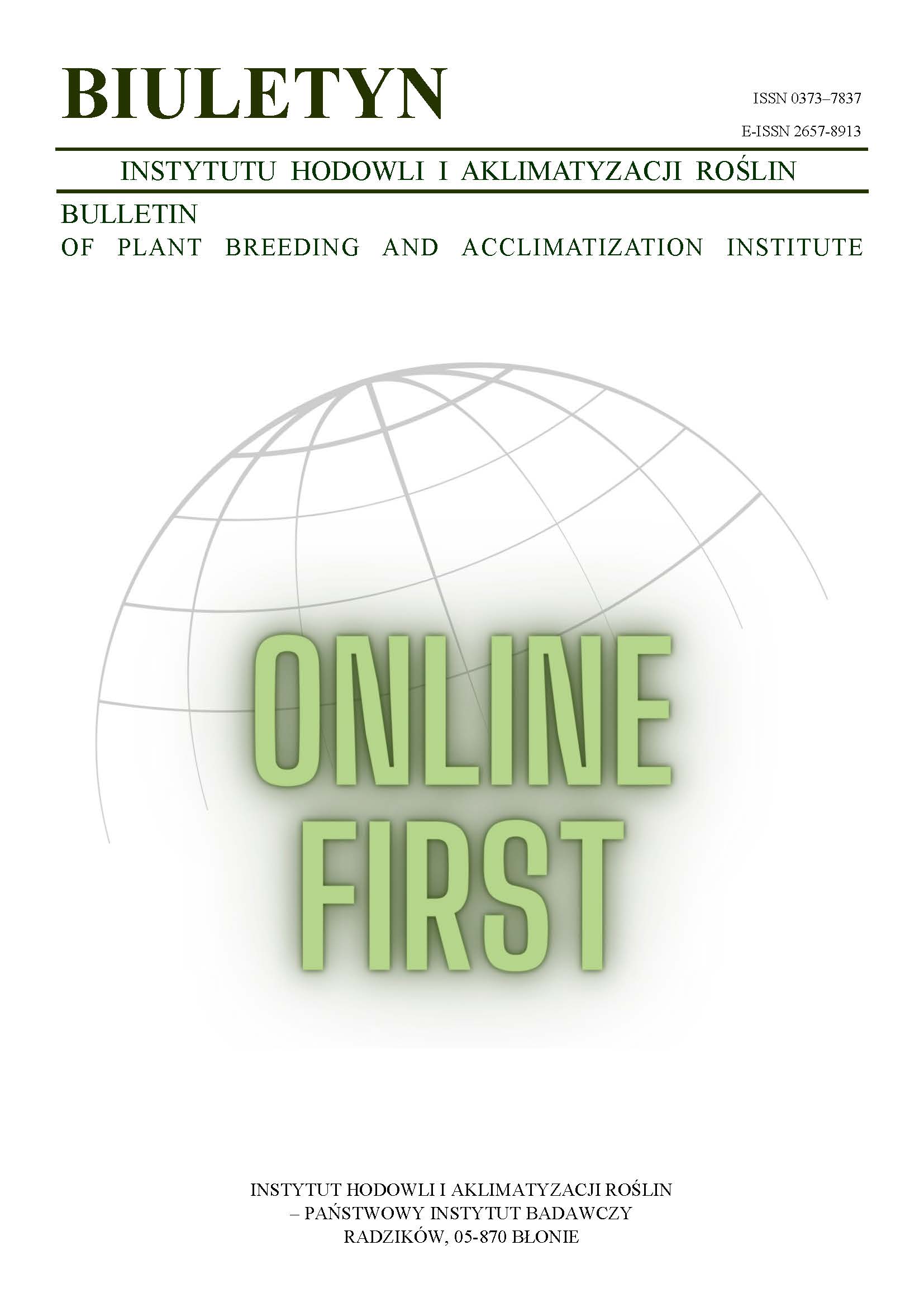Influence of autumn dressing of potato seed tubers on the of limitation fungi diseases development in storage
Edward Bernat
e.bernat@ihar.edu.plZakład Nasiennictwa i Ochrony Ziemniaka w Boninie, Instytut Hodowli i Aklimatyzacji Roślin w Radzikowie (Poland)
Abstract
Effectiveness of Tecto 450 FW and Fungazil 100 SL in limitation of occurrence of storage diseases was tested in the storage season 1999–2000. The seed dressers were applied on potato tubers a day after harvesting. The results showed that the tested Fungazil 100 SL reduced significantly black scurf and silver scurf during the storage season. Influence of the tested fungicides on inhibition of dry rot and gangrene was not observed.
Keywords:
fungi diseases, fungicide seed dressers, potato, storage seasonReferences
Czerko Z. 2002. Technologia przechowywania oraz zasady budowy nowoczesnych obiektów przechowalniczych. W: Produkcja i rynek ziemniaków jadalnych. Pr. zbior. pod red. J. Chotkowskiego. Wyd. „Wieś Jutra”:234 — 248.
Google Scholar
Errampalli D., Saunders J. M., Holley J. D. 2002. Evergreens of silver scurf (Helmithosporium solani) as an economically important disease of potato. Plant Patology, vol. 50, iss. 2: 141.
DOI: https://doi.org/10.1046/j.1365-3059.2001.00555.x
Google Scholar
Häni G. A., Gindrat D., Munster J., Walther U., Corun P. 1976. Bekampfung der Kartoffelpocken (Rhizoctonia solani Kuhn): quecksilberfreie Beizmittel und Bekämpfungsschwelle — Schweizerische landwirtschaftliche Forschung. Band 15, Heft 3/4: 473 — 487.
Google Scholar
Kapsa J., Lewosz J., Osowski J., Gawińska H. 1998. Parch srebrzysty (Helmithosporium solani) i jego występowanie w Polsce. Mat. konf. Ochrona Ziemniaka: 21 — 24.
Google Scholar
Meijers C. P. 1981. Maatreglen tegen nitbreiding van Rhizoctonia tijdens de bewaring van aarodopplen. Landbouw Machanisatie, 32: 19 — 21.
Google Scholar
Niehuss M. 1981. Angaben zur Rhizoctonia solani Kuhn an Kartofflen. Der Kartoffelbau 4: 33 — 35.
Google Scholar
Smith I. M., McNammara D. G., Scott R. R., Harris K. M. 1994. Grzyby — Phoma exigua var. fovveata. Kwarantannowe Agrofagi Europy. Prac. zbior.: 594 — 600.
Google Scholar
Sowa-Niedziałkowska G. 2000. Wpływ warunków wzrostu roślin i magazynowania bulw odmian jadalnych ziemniaka na ich trwałość przechowalniczą. Biul. IHAR, 213: 225 — 232.
Google Scholar
Tsror (Lahkim) L., Peretz-Alon I., van de Haar J. J. 2002. Control of silver scurf on potato. Mat. 15th Triennial Conference of the EAPR, Hamburg: 34.
Google Scholar
Authors
Edward Bernate.bernat@ihar.edu.pl
Zakład Nasiennictwa i Ochrony Ziemniaka w Boninie, Instytut Hodowli i Aklimatyzacji Roślin w Radzikowie Poland
Statistics
Abstract views: 12PDF downloads: 7
License
Copyright (c) 2004 Edward Bernat

This work is licensed under a Creative Commons Attribution-ShareAlike 4.0 International License.
Upon submitting the article, the Authors grant the Publisher a non-exclusive and free license to use the article for an indefinite period of time throughout the world in the following fields of use:
- Production and reproduction of copies of the article using a specific technique, including printing and digital technology.
- Placing on the market, lending or renting the original or copies of the article.
- Public performance, exhibition, display, reproduction, broadcasting and re-broadcasting, as well as making the article publicly available in such a way that everyone can access it at a place and time of their choice.
- Including the article in a collective work.
- Uploading an article in electronic form to electronic platforms or otherwise introducing an article in electronic form to the Internet or other network.
- Dissemination of the article in electronic form on the Internet or other network, in collective work as well as independently.
- Making the article available in an electronic version in such a way that everyone can access it at a place and time of their choice, in particular via the Internet.
Authors by sending a request for publication:
- They consent to the publication of the article in the journal,
- They agree to give the publication a DOI (Digital Object Identifier),
- They undertake to comply with the publishing house's code of ethics in accordance with the guidelines of the Committee on Publication Ethics (COPE), (http://ihar.edu.pl/biblioteka_i_wydawnictwa.php),
- They consent to the articles being made available in electronic form under the CC BY-SA 4.0 license, in open access,
- They agree to send article metadata to commercial and non-commercial journal indexing databases.
Most read articles by the same author(s)
- Edward Bernat, Jerzy Osowski, The use of decision support system NegFry to late blight control , Bulletin of Plant Breeding and Acclimatization Institute: No. 256 (2010): Regular issue
- Edward Bernat, A way of controlling the occurrence of Rhizoctonia solani under conditions of Western Pomerania , Bulletin of Plant Breeding and Acclimatization Institute: No. 243 (2007): Regular issue
- Edward Bernat, The practical use of decision support system NegFry in potato cultivation , Bulletin of Plant Breeding and Acclimatization Institute: No. 266 (2012): Regular issue
- Jerzy Osowski, Edward Bernat, Hanna Gawińska-Urbanowicz, Józefa Kapsa, The incidence and control of pathogens in potato crops in the year 2003 , Bulletin of Plant Breeding and Acclimatization Institute: No. 233 (2004): Regular issue
- Józefa Kapsa, Edward Bernat, Małgorzata Kasprzak, The usefulness of NegFry decision support system in potato protection against late blight under different meteorological conditions , Bulletin of Plant Breeding and Acclimatization Institute: No. 237/238 (2005): Regular issue
- Edward Bernat, The efficacy of certain fungicides in controlling late blight depending on metrological condition , Bulletin of Plant Breeding and Acclimatization Institute: No. 233 (2004): Regular issue
- Edward Bernat, New possibilities of chemical protection against early and late blights in potato crops using a fungicide Pyton Consento 450 SC , Bulletin of Plant Breeding and Acclimatization Institute: No. 233 (2004): Regular issue
- Edward Bernat, The occurrence of black scurf (Rhizoctonia solani) on tubers of some potato varieties , Bulletin of Plant Breeding and Acclimatization Institute: No. 237/238 (2005): Regular issue














